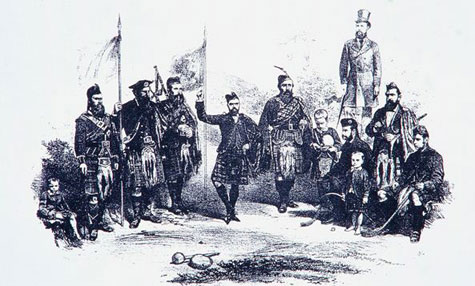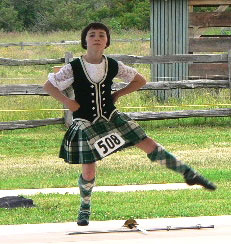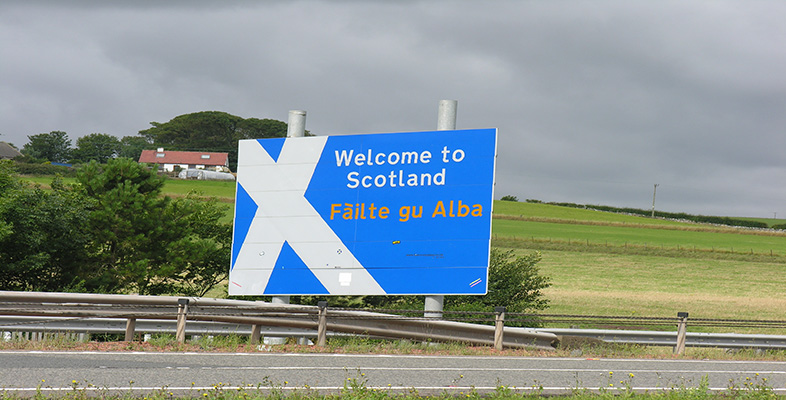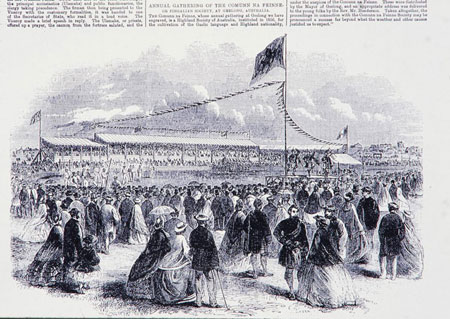6.3 Dance
Historical background
Of all the Gaelic art forms, dance has had, perhaps surprisingly, the least impact and it is in its modern manifestations and representations through Highland Games that it is best known. Many current forms of dance activity have displaced older versions, or are modifications of ritual celebrations and some have, over time, become more associated with children’s play activities and entertainment. There are also interesting sub-sets of mainstream activity, with military institutions developing their own interests and styles, the most notable being the introduction of Highland dancing to the Royal Edinburgh Military Tattoo [Tip: hold Ctrl and click a link to open it in a new tab. (Hide tip)] .
Throughout the world, however, Highland dancing is recognised as one of the iconic activities of Scotland and its presence on the global stage is, in no small measure, due to the presence of Highland émigrés from the 19th century in particular. Highland dancing was, simply, one of the cultural anchors which enabled a displaced people to entertain themselves and retain some semblance of their life back in the home country in, for example, Geelong, Australia.
Step dance in Canada
Although step dancing is unique to Canada, there are three distinct styles within the country: Cape Breton Style, French Canadian Style and Ottawa Valley Style. All three draw heavily on the traditions of dance in Scotland and Ireland and were brought to Canada by emigrants from the Highlands of Scotland and Ireland.
Step dancing is a fast paced, rugged and energetic style of dance usually performed to traditional fiddle music. It generally requires limited surface movement and is concentrated on foot work involving limited hand and arm motion. Step dancing is usually performed on a board with a hard, smooth surface, wearing character shoes with special clickers attached to the toe and heel. Similar to Highland country dancing and Irish dancing, it has a competitive element beyond its social context of community dances.
Step dancing follows the popular pattern of an eight-bar step. Although the traditional method of right then left foot is most common among dancers, many times dancers creatively dance on only one foot before moving on to the next step. This is usually done when creating steps defined for a specific piece of music.
There are many different types of step dances. All have different tempos, timing and accents. The different dances include: reels, jigs, clogs, strathspeys, hornpipes, waltz-clogs, polkas, and two-steps.
Highland dancing
The modern term Highland dance or Highland dancing is used today to refer to a style of athletic solo dancing which developed in the Gaelic Highlands of Scotland. It now has a hugely competitive element at Highland Games, attracting world-wide interest and participation, which contrasts significantly with the concept of ceilidh or community dancing.
Highland dance evolved into its current form during the 19th and 20th Centuries largely in the context of competitions at Highland games), where it is often performed to the accompaniment of Highland bagpipe music and comes with an elaborate structure of judging and performance ritual.
Highland dancing is not the same as Scottish country dancing, which is both a social dance like ballroom dancing (that is, a dance which is danced with a partner or partners) and a formation dance similar to square dancing (a dance in which an important element is the pattern of group movement about the dance floor).
Some Highland dances do derive from traditional social dances, however. An example is the Highland Reel, also known as the Foursome Reel, in which groups of four dancers alternate between solo steps facing one another and a figure-of-eight style with intertwining progressive movement. Most Highland dances are performed solo. Highland Dance is recognised as a sport by Sportscotland.
Dancing with swords and kilts
It seems that forms of sword dancing have been performed by warriors in many parts of Europe over a long period of time. Ritualistic and combative dances portraying epic deeds and martial skills were a familiar feature in Scottish tradition and folklore.
The British Government's policy of suppression against Highland culture culminated in 1747 with the Act of Proscription, banning the wearing of kilts by civilian males. The Act was repealed in 1782 and in the early 19th century, there was something of a romanticisation of Highland culture.

The process of romanticisation received the royal seal of approval with the public wearing of the kilt by George IV in 1822; henceforth tartan’s popularity was assured. Queen Victoria’s subsequent enthusiasm for aspects of Highland culture included piping and dancing and it was during this period that dancing became popular at Highland Games public events.
Highland dancing was an integral part of the games from the very start of their modern revival, but the dances performed at games were mostly for the convenience of judges. Many older, traditional dances were lost at this time as they were not required for competition.
Organisation
Many Highland gatherings worldwide, and almost all in the United States, recognise the Scottish Official Board of Highland Dancing (SOBHD), formed in 1950, as the world governing body of Highland dancing. A World Highland Dance Championship has been held annually at the Cowal Highland Gathering since 1934.
Highland dances
The Sword Dance
Highlanders are said to have developed the sword dance ‘as a necessary preparation for the management of the broad-sword… used in certain dances to exhibit their dexterity’ (Logan, James. The Scottish Gael p. 440).
This included dancing over two naked swords which are laid across each other on the floor, some while a dancer moves nimbly around them. Dexterously placing the feet by a peculiar step in the intervals between crossed blades, as in the ‘Gillie Chaluim’, has long been linked with dances before a decisive battle or as a victory dance.
Legend has it that on the eve of battle Highland chiefs would call out the clan’s best dancers, who would dance the sword dance. If the dancers successfully avoided touching either blade, then it was considered an omen that the next day's battle would be in the clan’s favour.
A more practical explanation behind the meaning of this dance can be found in the training halls of older styles of fencing, where students of the sword developed their footwork by following geometric patterns of crosses, squares and triangles marked out on the floor. Click here to see an example.
The Highland Fling
One of the best known Highland Dances is the Highland Fling, said to be a dance of triumph at the end of a battle. Another (no less romantic) theory is that it was performed before battles (like the sword dance), on top of the dancer’s shield. The shield would have a spike in the middle, around which the dancer would do the dance that involves flicking of the feet, jumping and careful stepping supposedly to drive evil spirits away. The dancer is confined to one spot.
The Reel of Tulloch
Ruidhle Thulaichean (anglicised as ‘The Reel of Tulloch’) is said (perhaps dubiously) to have originated when a congregation had to wait at a church for a minister on a cold wedding day. During the delay they allegedly whistled a Highland tune while someone improvised a dance. A more gruesome version of the story is that the dance derives from a rough game of football that some workmen building a castle played when they unearthed a human skull. A variation is that inhabitants of of Tulloch played with the severed head of an enemy.
The genesis of the song is discussed in an article entitled ‘The reel of Tulloch in fact and fiction’, about the folklore attached to it and the so-called Tulloch Tragedy, published in The Transactions of Gaelic Society of Inverness (volume LIX, pages 118-128).
The song itself is published in Archibald Sinclair’s 1879 collection An t-Òranaiche.
Their britheamhan na tìre
Ma labhras iad an fhìrinn:
‘De na thig de cheòl à fidhlean
S e rìgh dhiubh Na Tulaichean.’
The judges of this land
Will say if you believe them:
‘When music comes from any fiddle
the Reel of Tulloch’s the King.’
You can see a photo of soldiers dancing the Reel of Tulloch here.
Seann Triubhas
The Seann Triubhas (pronounced ‘shawn trewas’ and meaning ‘old or unwanted trousers’ in Gaelic) is romantically associated with the proscription of Highland garb after the 1745 rebellion. The steps involve much shaking of the legs, symbolic of shedding the dreaded ‘trewes’; the final, faster step(s) show the joy of returning to the kilt. However, the dance is considerably younger, with most of the steps performed today dating from the late 19th century.
Like other dance traditions, what is called ‘Highland dancing’ is a hybrid form that has been constantly changing according to contemporary aesthetics and interpretations of the past. While some elements may be centuries old, other elements are much more modern. The vast majority of dances now performed were composed in the last century.

Country dancing
Scottish country dances are categorised as reels (including hornpipes), jigs, and strathspeys, according to the type of music to which they are danced. The first two types (also called quick-time dances) feature fast tempos, quick movements and a lively feel. The third type (strathspey) has a much slower tempo and a more formal, stately feel. There are also 9/8 jigs, minuets and waltz-time dances, although they make up a very small part of the repertoire.
Dancers and sets
Scottish country dancing is generally done in organised formations referred to as ‘sets’. Sets usually consist of three or four couples, but some dances call for larger sets of five, six or even more couples. Couples are usually mixed, but women will dance with women or men with men depending on the make-up of the assembly.
Scottish country dancing is a hugely social and inclusive activity which is enjoyed by many, of all ages. Many SCD groups enjoy putting on ‘demonstrations’ showing near-to-perfect dancing involving all aspects of technique.
Modern country dancing and the Royal Scottish Country Dance Society
During the early 20th century, Scottish country dance still had a part in social entertainment especially in rural Scotland, even though the number of dances within the active repertoire had diminished. Country dancing was in danger of dying out when in 1923 the Scottish Country Dance Society (SCDS) was founded in Glasgow, with the goal of preserving ‘country dances as danced in Scotland’ (this was only recently changed to read ‘Scottish country dances’).
The SCDS began to collect and publish the remaining dances as well as reconstruct (or reinterpret) from old sources dances that were no longer being danced. In the process, the dances and technique, which might differ considerably depending on where in Scotland a dance would be collected, were strictly standardised.
The society achieved Royal patronage in 1947 and became known as the Royal Scottish Country Dance Society (RSCDS).
Fairly soon after the inception of the SCDS people started inventing new dances in the spirit of the older ones, but also introducing new figures not part of the ‘traditional’ canon. Today there are over 11,000 dances catalogued, of which fewer than 1,000 can be considered ‘traditional’.
Hebridean dance
The term ‘Hebridean dancing’ is a fairly modern one and probably first came into use at the English Folk Dance and Song Society’s festival at the Royal Albert Hall, London in 1934, when Fearchar Macneil from Barra was asked to perform some dances known in South Uist and Barra. It is believed that these dances acquired this label to differentiate them from the more widely known Highland dances and to pinpoint their place of origin.
The solo dances now embraced by the term Hebridean dances, and of which several versions are known, are Tulloch Gorm, Highland Laddie, Over the Water to Charlie, (Scotch) Blue Bonnets, Flowers of Edinburgh, First of August, Scotch Measure and Aberdonian Lassie.
Only fragments of the dances Jacky Jar, The Lads wi’ the Kilt, Over the Water and Over the Hill, Carraig Fhearghais, Over the Hills and Far Away, and Petronella survive to this day.
It is not known with any certainty where these dances originated but we do know that dances bearing these names were all taught by dancing master Eòghann Mac Lachlainn (Ewen MacLachlan), c. 1799-1879, who taught dancing primarily in South Benbecula, South Uist, Eriskay and in Barra in the mid-1800s.
The dances, as we know them today, are performed in a more relaxed and rather spontaneous manner than Highland dancing, and they often involve a great deal of percussive footwork.
In the mid-1980s there was a move amongst the local people in Barra and South Uist to preserve these dances which could have been lost forever. There were still several people on the islands who knew these dances from their youth and had been taught them by pupils of pupils of Ewen MacLachlan.
The dances were subsequently introduced to Fèis Bharraigh (Barra Festival) and in both South Uist and Barra the dances were introduced to children by local tradition bearers.
The television documentary Tiugainn a’ Dhannsa (‘Let’s Dance’) examined the role of village halls in Scottish communities throughout the 20th century. These former centres of music and dance have been torn down in many areas to be replaced by buildings catering to the needs of a very different generation. The programme used nostalgic anecdotes to recall the heyday of the village dance. The book Hebridean Dances: Dannsa nan Eileanach (published by Acair Ltd and illustrated by Jon Paul) has 12 detailed descriptions and diagrams of dances from Barra.
Modern dance
Creative Scotland helps to develop dance in Scotland through support of dance-based organisations, buildings, and choreographers, along with developing audiences. Scottish Dance Theatre is Scotland’s national contemporary dance company.

